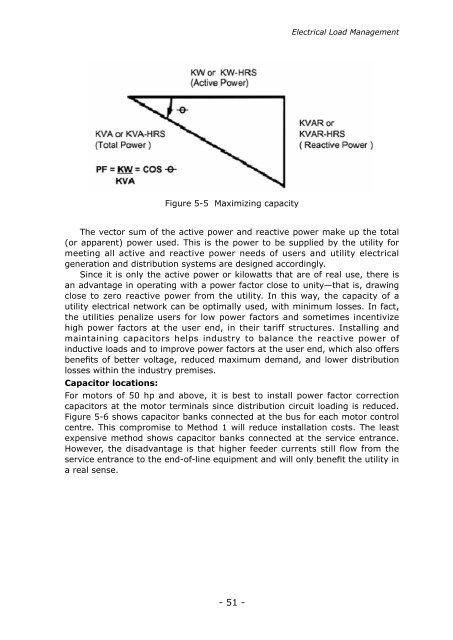Training Manual on Energy Efficiency - APO Asian Productivity ...
Training Manual on Energy Efficiency - APO Asian Productivity ...
Training Manual on Energy Efficiency - APO Asian Productivity ...
Create successful ePaper yourself
Turn your PDF publications into a flip-book with our unique Google optimized e-Paper software.
Figure 5-5 Maximizing capacity<br />
The vector sum of the active power and reactive power make up the total<br />
(or apparent) power used. This is the power to be supplied by the utility for<br />
meeting all active and reactive power needs of users and utility electrical<br />
generati<strong>on</strong> and distributi<strong>on</strong> systems are designed accordingly.<br />
Since it is <strong>on</strong>ly the active power or kilowatts that are of real use, there is<br />
an advantage in operating with a power factor close to unity—that is, drawing<br />
close to zero reactive power from the utility. In this way, the capacity of a<br />
utility electrical network can be optimally used, with minimum losses. In fact,<br />
the utilities penalize users for low power factors and sometimes incentivize<br />
high power factors at the user end, in their tariff structures. Installing and<br />
maintaining capacitors helps industry to balance the reactive power of<br />
inductive loads and to improve power factors at the user end, which also offers<br />
benefits of better voltage, reduced maximum demand, and lower distributi<strong>on</strong><br />
losses within the industry premises.<br />
Capacitor locati<strong>on</strong>s:<br />
For motors of 50 hp and above, it is best to install power factor correcti<strong>on</strong><br />
capacitors at the motor terminals since distributi<strong>on</strong> circuit loading is reduced.<br />
Figure 5-6 shows capacitor banks c<strong>on</strong>nected at the bus for each motor c<strong>on</strong>trol<br />
centre. This compromise to Method 1 will reduce installati<strong>on</strong> costs. The least<br />
expensive method shows capacitor banks c<strong>on</strong>nected at the service entrance.<br />
However, the disadvantage is that higher feeder currents still flow from the<br />
service entrance to the end-of-line equipment and will <strong>on</strong>ly benefit the utility in<br />
a real sense.<br />
- 51 -<br />
Electrical Load Management
















